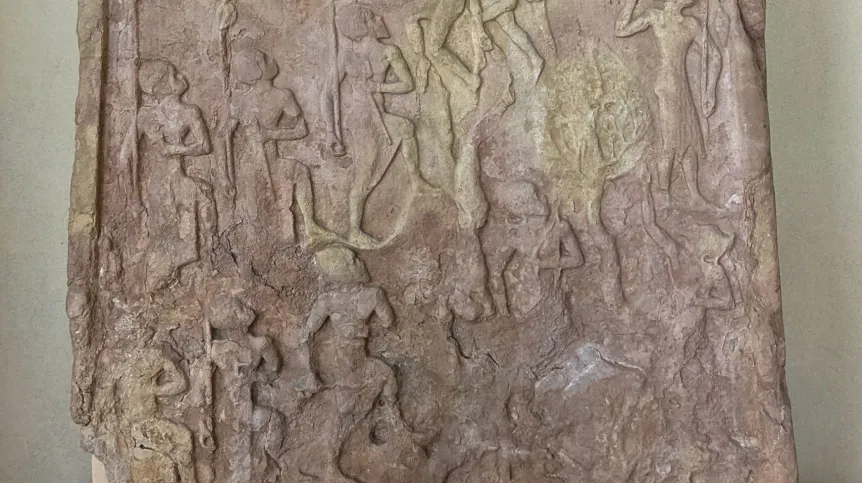
The level of violence among ancient human communities in the Middle East fluctuated greatly throughout history and depended on the social life conditions in particular eras.
An international team including Dr. Arkadiusz Sołtysiak from the Faculty of Archaeology at the University of Warsaw and economic historians - Dr. Giacomo Benati from the Universitat de Barcelona and Professor Jörg Baten from Eberhard Karls Universität Tübingen - conducted an extensive analysis of the traces of interpersonal violence in the Middle East, the region where agriculture, a sedentary lifestyle and developed countries first appeared.
The scientists' findings were published in the journal Nature Human Behaviour.
'Given that homicide records are only available for the more recent period, much of human history remains outside our purview’, the authors write in their paper. 'By documenting variations in violence patterns across a vast temporal and geographical scale in an incredibly rich historical setting, we broaden perspectives on the early history of human conflict.’ Dr. Sołtysiak adds that it is also interesting from the point of view of considerations about the characteristics of early human nature and the role of violence in the development of human civilization.
Therefore, the researchers analysed data on skull injuries in a collection of over 3,500 skeletons found in various regions of the Middle East: Turkey, Iran, Iraq, Syria, Lebanon, Israel, Jordan. They originate from various periods between 12,000 and 400 BCE.
The focus was on skulls that were damaged above the so-called hat-brim line, at the height determined by the brim of a typically worn hat. In science, it is assumed that injuries above this line are of active origin (resulting from an intentional impact), while those below this line are of passive origin (resulting from an accident).
Additionally, the scientists examined other parts of the skeletons for signs of weapon-related injuries. 'If we have sufficiently large skeleton collections, we can estimate the level of violence in various ancient human groups based on the frequency of injuries resulting from the use of weapons. In particular, blows made with hand-held blunt or sharp edge weapons may leave characteristic marks on the bones, especially on the skull vault,’ Dr. Sołtysiak says.
The data allowed researchers to determine a certain trend: in the earliest times (in the Neolithic period, approx. 9000–4500 BCE), the level of interpersonal violence was very low. At the time, people lived mainly in small, scattered villages. When they began to organise themselves into larger settlements and the first centralised states, in the Chalcolithic period (around 4500–3200 BCE), the number of injuries increased rapidly, especially in Mesopotamia. The next period of history brought a noticeable decline in the level of violence - this situation persisted from the Early (approx. 3200-2100 BCE) to the Middle (approx. 2100-1500 BCE) Bronze Age. The trend reversed again in the Late Bronze Age (ca. 1500-1200 BCE) and the Iron Age (ca. 1200-400 BCE), when the incidence of injuries increased relative to the Early Bronze Age, although it was still lower than in the Chalcolithic.
Importantly - the Polish archaeologist emphasises in an article posted on the blog Archeowiesci.pl - this trend looks very similar in different parts of the Middle East, although the overall frequency of injuries was clearly lower in Mesopotamia and higher in Anatolia and Iran.
'Considerations on a community's tendency to violence should primarily take into account the circumstances,’ says Dr. Sołtysiak 'People may be less inclined to be aggressive when the state does not control their behaviour, like in the Neolithic, and when there is a strong state that maintains order, like in the Bronze Age. Analyses show that violence becomes more common in times of increased stress, either related to the emergence of new institutions that have not yet developed the ways of relieving the social tension associated with rapid urbanisation, like in the Chalcolithic period, or with the collapse of institutions, like in the Iron Age.’
The researchers conclude that because the incidence of injuries neither decreased nor increased systematically over time, it means that the level of interpersonal violence depended less on the progress of civilization itself and more on the specific conditions shaping the social life in particular eras.
The first farmers, the researcher writes on Archeowiesci.pl, lived in small, coherent, to some extent isolated groups that did not have to compete with each other for resources. However, as the population grew significantly and the first states began to emerge, greater social tensions began to arise, which could result in a dramatic increase in the level of violence, both within and between the new states. As statehood developed, institutions emerged, including those of a police nature, allowing for the gradual reduction of violence within societies; maintaining order in cities. Although wars continued, armies became largely professional, which also greatly reduced the risk of injury to non-soldier citizens.
However, at the end of the Late Bronze Age, serious crises began to occur, resulting, among other things, from mass migrations from outside the region and internal tensions. Many powers of that time collapsed or were significantly weakened. 'This several-hundred-year period of unrest is described in the sources as a time of conflict between city inhabitants and shepherds, but also of an unstable situation in the cities themselves, where the weakening or even collapse of the central administration certainly resulted in a reduced sense of security,’ writes Dr. Sołtysiak.
In his opinion, one thing is certain: the main factor contributing to reducing the level of violence was the existence of a strong central authority that had appropriate institutions (courts, police forces) to ensure social peace.
However, as the authors of the publication emphasise, there is one more factor - apart from socio-economic shocks - that may influence the level of interpersonal violence; it is the changing climate. Research has revealed that, for example, the 300-year drought that took place during the period under study and contributed to mass migrations and widespread hunger, was also associated with a noticeable increase in the frequency of head injuries among the population.
This discovery is significant because currently the Earth is also in a difficult climatic situation. Many experts fear that conflicts around the world will intensify due to the rise in temperatures. However, the co-author of the study Dr. Giacomo Benati says that our times are quite different from the past. 'There is substantial evidence that extreme climate events could impact levels of conflict. But it is also true that (...) when there are institutions that are capable of reducing and capping violence, the conflict could be reduced,’ he says. (PAP)
Katarzyna Czechowicz
kap/ bar/ kap/
tr. RL













